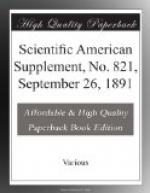During exercise there is obviously more abundant absorption of oxygen, and consequently greater elimination of carbonic acid, and as a consequence (as shown by researches of Voit), the reserve fat of the economy is attacked and diminished; in intense labor there is an average hourly consumption of about 8.2 percent. of fat. Further physical activity is useful in exercising the voluntary muscles, and thus opposing the invasion by interstitial fat of the muscle fibrils. Extreme exercise also, to a certain degree, exerts a favorable influence on the cardiac muscle, augmenting both its nutrition and its capacity for labor. With the anaemic obese, however, it is necessary to be most circumspect in prescribing forced exercise; also with the elderly obese possessed of enfeebled or fatty heart.
Hydrotherapy, especially in the form of cold douches, particularly when combined with massage, is often of considerable value in relieving obesity; the method of Harmman, of St. Germain, which has in many instances induced rapid loss of adipose, is of this class. Tepid saline baths and vapor baths have many advocates, and may afford material aid when the heart and circulation do not inhibit their employment. Hot baths elevate the temperature of the body and increase the organic exchanges, hence, as Bert and Reynard have pointed out, tend to the elimination of oxygen and carbonic acid; but when employed, the patient should be introduced while the temperature is below 130 deg. F., when it may be gradually raised in the course of thirty or forty minutes to 140 deg. F.
It has already been intimated, the chief feature of the treatment of obesity is acceleration of the exchanges; and this is in the main true, though it must also be borne in mind that, while there are obese who excrete little urea and have a depressed central nervous temperature, many may be azoturic, and besides eliminate phosphate in excess, when an oxidating treatment will not only fail, but prove positively injurious.
The bile throws out fat, therefore, to accelerate nutritive oxidations, the liver and nervous system must be acted upon, i.e., stimulated. Everything that tends to diminish the activity of the former, or depress the latter, must be avoided. Hence intellectual labor should be encouraged, or in lieu thereof, travel advised. Exercise should be taken chiefly while fasting; the limits of sleep confined to strict necessity, and siestas after meals and during the day strictly forbidden; the skin stimulated by hydro-therapeutic measures, including massage under cold affusions, during warm salt baths, etc.
To increase the activity of the liver, salicylate of soda may often be advantageously administered for its cholagogue effect; or resort may be had to saline purgatives such as are afforded by the springs of Marienbad, Kissengen, Homburg, Carlsbad, Brides, Hunyadi, or Chatel-Guyon; and it is somewhat remarkable that while undergoing a course of these waters, there is often no appreciable change in weight or obesity, though the decrease becomes most marked almost immediately upon cessation of treatment.




